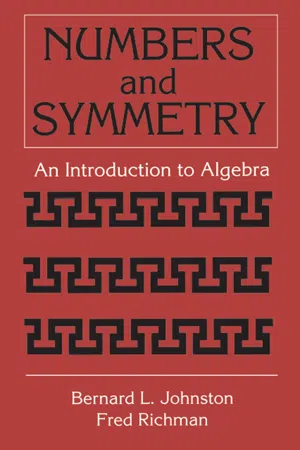Algebra begins with the natural numbers {1,2,3,…}, which we can add and multiply. By expanding to the integers
we can also subtract any two numbers—a great convenience. A system of numbers, or number-like things, in which we can add, subtract, and multiply is called a ring. We speak of “the ring of integers” when we want to call attention to the fact that we add, subtract, and multiply integers.
We can’t always divide one integer by another (why not?). This can be an inconvenience, but it gives the integers an interesting structure. Actually, we can always divide by nonzero integers, if we allow something to be left over—a remainder: 37 divided by 5 is 7, with 2 left over. But the number 37/5 is not an integer, and when we say that 40 is divisible by 8, we mean that there is no remainder.
Modern algebra deals with new kinds of numbers. We can construct new integers by thinking geometrically. The ordinary integers can be thought of as equally spaced points on the number line—a onedimensional arrangement:
What about other equally spaced arrangements of points? Can we make points in the plane, or on the circle, into numbers? It turns out that there is a natural two-dimensional version of the integers, the Gaussian integers, and infinitely many circular versions.
1.1 A planeful of integers, Z[i]
Imagine the ordinary plane with an x-axis and a y-axis drawn in. How can we think of points in the plane as numbers, that is, how can we add, subtract, and multiply them? The ordinary integers are points on the x-axis, the integer n located at the point with coordinates (n, 0). We know how to add and multiply them.
There is a natural way to add points in the plane that is like the way we add points on the x-axis. What is the geometric meaning of adding ordinary integers? The notion of adding 2 can be represented by an arrow from 0 to 2, indicating the displacement 0→2: move 2 steps to the right.
To add 2 to any number n, take that arrow and slide it along the x-axis until its base is on n. The tip of the arrow is then on n + 2. Here is the geometry of adding 2 to 3:
We may think of the number 2 as being the arrow which emanates from 0 and ends at 2; that is, we can think of 2 as meaning “move two steps to the right.” On this view, the integers are not so much points as displacements, represented by arrows that start at 0. When we add 2 to 3 we put two arrows together to get a third—if we move 3 steps to the right, then 2 steps to the right, the total effect is to move 5 steps to the right.
This procedure tells us not only how to add two integer points on the x-axis, it tells us how to add any two points on the x-axis. It also works with negative numbers. The arrow that represents subtracting 5, or adding −5, goes from 0 to −5; move 5 steps to the left.
To add −5 to 3, take the arrow and slide it along the x-axis until its base is on 3. Its tip is then on 3 − 5 = −2.
Again the result can be thought of as a displacement: moving 3 steps to the right, then 5 steps to the left, has the same effect as moving 2 steps to the left.
We can use this idea to form the sum a + b of any two points in the plane. Draw an arrow from 0 to b to represent adding b. Slide the arrow over, without rotating it, until its base is on a. Its tip is then on a + b.
If we identify points with displacements, that is, with arrows starting at 0, then this method of adding points is called vector addition. What does the picture look like if we construct b + a instead of a + b? In this case we take the arrow from 0 to a and slide it along without turning it so that its base is on b. The point b + a is then the point at the tip of this arrow. The two lines we have already drawn above form two sides of a parallelogram. The bottom side of this parallelogram is where the arrow from 0 to a goes. If we slide that arrow so that its base is on b, it forms the top side of the parallelogram with its tip on a + b. So b + a = a + b, because adding a to b comes from looking at o...






